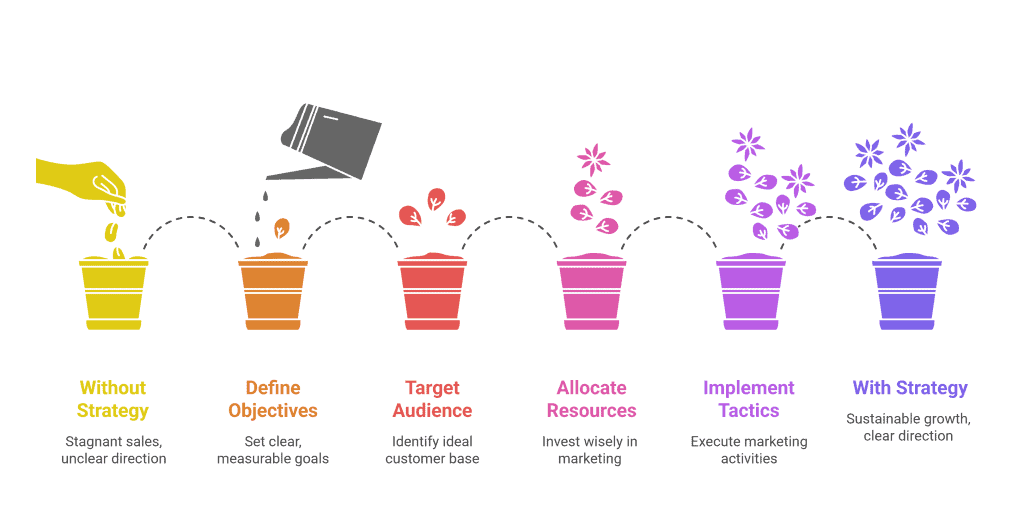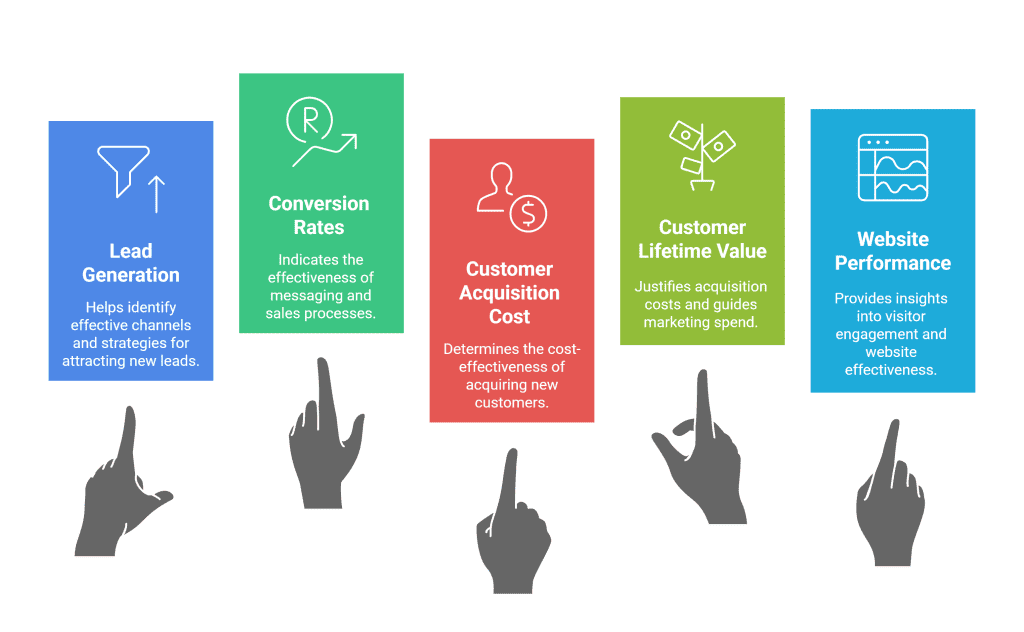Marketing Strategy, Marketing Tips
The Accidental Marketer’s Guide to Creating a Growth Strategy

The Accidental Marketer’s Blueprint for Sustainable Business Growth
Many business owners and managers find themselves managing marketing without ever planning to. These “accidental marketers” are individuals who have taken responsibility for marketing within a company because no one else was available or because it fell naturally into their role. For SMEs, this is a common scenario, as resources are often limited and hiring a full-time marketing professional may not be financially viable.
The challenge is that marketing without training or structure can become frustrating. Budgets are spent on activities that do not generate results, campaigns are inconsistent, and decision-making is reactive rather than strategic. Yet with the right approach, accidental marketers can transform ad hoc activity into a growth strategy that drives results.
Opportunity marketing helps accidental marketers transform ad hoc activity into a structured growth strategy that delivers measurable results. We provide SMEs with the clarity, confidence, and direction to make smarter marketing decisions, aligning every action with business objectives. Through our strategy-first consultancy, mentoring, and tailored plans, we support business owners and managers in turning marketing into a reliable driver of sustainable growth. Contact Us: 0333 320 4108 or info@opportunitymarketing.co.uk. Website: www.https://opportunitymarketing.co.uk
Understanding the Role of the Accidental Marketer
The accidental marketer is often a business owner, director, office manager, or junior employee who has marketing responsibility added to their existing workload. While this can seem manageable at first, it quickly becomes overwhelming when faced with the complexity of marketing channels, advertising options, customer behaviour, and reporting.
One of the biggest risks is defaulting to tactics without a strategy. For example, a company might spend money on Facebook ads because a competitor does or run events because they “seem like a good idea”. Without a plan, these actions rarely generate a consistent return on investment.
Accidental marketers often face three recurring problems:
Wasted spend – money is allocated to campaigns without knowing if they work. This can involve repeated payments for advertising subscriptions or agency retainers that deliver little or no measurable results. It is particularly damaging for SMEs because every marketing pound must work as hard as possible.
Inconsistent branding – messages and design vary depending on who is handling the activity. This inconsistency confuses potential customers and can reduce confidence in the business. It might mean one email looks professional while the next appears rushed and poorly presented. Over time, inconsistent branding undermines the credibility of the company.
Lack of measurement – results are not tracked, so decision-making is based on guesswork. Without data, accidental marketers cannot tell which campaigns perform well or which should be stopped. This creates a cycle of repeated mistakes and poor allocation of resources.
Recognising these pitfalls is the first step toward becoming more structured. The next step is understanding why growth strategy matters and how it can change the trajectory of the business.

Why a Growth Strategy Matters for SMEs
A growth strategy is the structured plan that outlines how a business will achieve expansion and sustainability over time. For SMEs, where budgets are limited, having this roadmap is vital. It gives clarity, prevents wasted activity, and provides a framework for decision-making.
Operating without a growth strategy usually results in:
Stagnant sales – growth stalls because marketing activity is inconsistent. This leaves the business struggling to attract new customers and relying too heavily on a small base of existing clients. It also limits opportunities to scale, making the business vulnerable during economic downturns.
Unclear direction – businesses try multiple approaches but lack a clear identity or position in the market. They may launch campaigns on social media, attend trade shows, or run online ads without knowing how these fit together. This creates confusion both internally and externally, with customers unsure what the business actually stands for.
Financial risk – spending continues without knowing which activities work. SMEs cannot afford to waste budget on poorly targeted marketing. A lack of structure can mean investing in tactics that look appealing on the surface but fail to deliver meaningful results.
By contrast, a growth strategy provides:
Clarity – a defined target audience, clear objectives, and measurable outcomes. Everyone involved in marketing knows what the company is trying to achieve and how success will be evaluated. This avoids the risk of pursuing disconnected or low-value activities.
Confidence – decision-makers know why they are investing in specific marketing actions. Rather than guessing or copying competitors, they allocate budget and resources based on strategy. This provides reassurance that marketing spend is not wasted.
Sustainability – strategies are designed for long-term impact, not short-term gains. This allows SMEs to build consistent pipelines of leads, strengthen their brand reputation, and grow at a steady and manageable pace rather than experiencing spikes and slumps.
For an accidental marketer, this shift is transformational. Instead of guessing, they operate with a structured framework that aligns marketing spend with business objectives.

Core Foundations of a Successful Growth Strategy
Every successful strategy is built on solid foundations. Before creating a marketing plan, the business must define its purpose, objectives, and positioning.
1. Vision and Objectives
A clear vision describes where the business wants to be in the future. Objectives make that vision measurable. For example, a company might aim to increase turnover by 30 per cent in the next three years. Objectives should be specific, measurable, achievable, relevant, and time-bound (SMART). Setting objectives in this way makes it easier to review progress and identify whether marketing activities are contributing to the overall business goals.
2. Market Positioning
Positioning defines how a business wants to be perceived in the market. It requires identifying what makes the business unique and why customers should choose it over competitors. Positioning could be based on price, service, expertise, or innovation. Strong positioning helps a business stand out and prevents it from being lost in a crowded marketplace.
3. Audience Understanding
Knowing the customer is the foundation of all effective marketing. This involves creating buyer personas that describe customer demographics, behaviours, pain points, and purchasing drivers. For SMEs, personas might include details such as job titles, typical challenges faced, decision-making authority, and preferred communication channels. Understanding customer motivations makes it easier to design campaigns that attract and convert.

4. Competitive Analysis
Studying competitors helps identify opportunities and threats. Accidental marketers can analyse competitor websites, social media, advertising, and customer reviews to learn what works and what gaps exist. For example, if competitors rarely publish helpful content, creating valuable guides could position your business as an authority. Equally, analysing competitors’ weaknesses can highlight areas where your company can differentiate itself.
5. Strategic Roadmap
A roadmap pulls all of these foundations together. It sets the direction for the business, linking objectives, audience, and positioning to marketing actions that will drive growth. A roadmap should provide clarity on what needs to happen first, which activities should follow, and how progress will be monitored. For accidental marketers, it acts as both a guide and a reference point, reducing the risk of drifting back into ad-hoc decision-making.
Strategy Development – Turning Foundations into Action
Once the foundations are set, the next step is to develop the strategy itself. This involves turning broad objectives into actionable plans.
Step 1: Clarify Vision and Goals
Confirm long-term goals such as revenue targets, customer growth, or new market entry. Then break them into shorter-term objectives that can be tracked more easily. For instance, increasing website enquiries by 15% in six months could be one milestone that supports the longer-term goal of doubling customer numbers.
Step 2: Define the Offer and Pricing
Accidental marketers must confirm what they are selling and at what price. Is the offer premium, mid-range, or budget? Does the pricing align with the target audience’s expectations? A premium service needs to justify its price with clear value, while a budget offering must demonstrate efficiency and cost savings. This stage is critical for avoiding positioning errors that make it difficult to compete.
Step 3: Identify the Audience
Use research and customer feedback to create detailed personas. For SMEs, this might involve interviewing existing customers, reviewing sales data, or analysing website analytics. The more detail available about who the customer is, what they care about, and how they make decisions, the more precise marketing campaigns can be.
Step 4: Differentiate Against Competitors
Highlight what makes the business unique. This could be service quality, product innovation, customer experience, or pricing structure. For example, if a local competitor focuses on low prices, your business might stand out by emphasising superior customer service and long-term support. Differentiation makes the business memorable and gives customers a clear reason to choose it.

Step 5: Craft Messaging
Messaging should speak directly to the audience’s needs and pain points. For example, a small accountancy firm might focus on “taking the stress out of compliance” rather than promoting technical skills. Effective messaging uses the customer’s language, focuses on their problems, and positions the business as the solution. Creating a messaging framework can help maintain consistency across websites, social media, emails, and presentations.
Accidental marketers who follow these steps create a strategy that is not just theoretical but practical and actionable.
Marketing Planning: Creating a Practical Roadmap
Planning translates strategy into a structured plan of activity. Without a plan, marketing remains reactive and inconsistent.
Elements of a Strong Marketing Plan
Objectives and KPIs
Define what success looks like. This could include lead generation targets, revenue growth, website traffic, or brand awareness metrics. Each KPI should link directly back to the business objectives. For example, if the goal is to grow by 30%, then lead generation targets must align with that figure rather than being arbitrary.
Routes to Market
Identify which channels are most effective for the target audience. For B2B companies, this may include LinkedIn, email campaigns, and industry events. For B2C, it might involve social media platforms such as Facebook or Instagram, as well as local advertising. Each route to market should be justified with evidence that it reaches the right customers.
Content Planning
Map out content themes, topics, and formats that will engage customers. A three-month content calendar can be a good starting point, covering blogs, email newsletters, videos, and social posts. Each piece of content should have a purpose, such as educating customers, generating leads, or building trust.
Resource Allocation
Confirm budget, time, and staff available for marketing. SMEs often need to prioritise low-cost, high-impact activities such as referral programmes or organic content marketing. Allocating resources effectively also means deciding which tasks can be handled in-house and which should be outsourced.
Timeline
Plan when each activity will take place, with milestones for review. A timeline creates accountability and avoids marketing being left until “when there is time”. It also makes it easier to monitor whether activities are on track.

Why Planning Matters
Planning provides clarity, prevents wasted spending, and makes it easier to coordinate activities. For accidental marketers, a plan acts as a safety net, guiding activity week by week. It reduces the risk of last-minute, poorly thought-out campaigns and helps the business focus on consistent progress rather than sporadic bursts of activity.
Marketing Execution
Execution is where strategy meets action. This stage requires discipline, organisation, and consistency.
Avoiding Random Acts of Marketing
Many businesses fall into the trap of doing marketing only when sales are low. This results in short bursts of activity followed by silence. Execution should be consistent and aligned with the plan. Consistency builds brand recognition, maintains customer engagement, and prevents sales pipelines from running dry.
Execution Channels for SMEs
Email marketing is cost-effective and measurable, ideal for nurturing leads. Email campaigns can be personalised, automated, and tracked to understand open rates and conversions. They are particularly effective when paired with valuable content such as guides, offers, or invitations to events.
Social media platforms like LinkedIn for B2B and Facebook or Instagram for B2C provide a direct way to connect with audiences. Posting consistently, responding to comments, and engaging in relevant groups builds visibility. Paid campaigns can extend reach further if budget allows.

Networking and Events: Still powerful for SMEs, particularly in local markets. Attending industry events or joining local business groups helps create personal connections that lead to referrals and partnerships. Although time-intensive, this approach can yield high-value leads.
Referral Programmes: Leveraging existing clients to bring in new business is highly cost-effective. Creating structured referral programmes, with incentives for introductions, encourages satisfied customers to recommend the business.
PR and Case Studies: Building credibility through media coverage and publishing client success stories demonstrates expertise and builds trust. Well-written case studies can also be repurposed into presentations, blogs, and sales collateral.
Outsourcing vs In-House Execution
Accidental marketers often need to decide whether to outsource. Outsourcing can save time and bring expertise, but it requires clear direction to avoid being led by agencies. In-house execution gives more control but may be limited by skill or time. The best approach often involves a combination, with strategic oversight retained internally and tactical execution outsourced where specialist knowledge is required.
Testing, Measuring, and Reporting
Testing and measurement are critical to understanding what works and what does not. Without them, marketing becomes guesswork.
What to Measure
- Lead generation numbers: Track how many new enquiries or leads are generated from different campaigns. This helps determine which channels are most effective.
- Conversion rates: Measure how many leads become paying customers. A low conversion rate may suggest that messaging, pricing, or sales processes need improvement.
- Customer acquisition cost: Calculate how much it costs to win a new customer. This figure should be compared with the customer lifetime value to confirm profitability.
- Customer lifetime value: Estimate the total revenue a customer generates during their relationship with the business. Higher lifetime value justifies higher acquisition costs, while lower figures mean marketing spend must be more tightly controlled.
- Website performance: Review metrics such as traffic, bounce rate, and time on site. These indicators provide insights into whether the website engages visitors and encourages them to take action.

Tools to Use
- Google Analytics: Provides data on website performance, including visitor numbers, traffic sources, and behaviour.
- CRM Systems: Track leads, conversions, and customer interactions. This data highlights which marketing activities contribute most to revenue.
- Campaign Dashboards: Advertising platforms such as Google Ads or Facebook Ads Manager provide campaign performance data. Dashboards allow accidental marketers to adjust campaigns quickly if results are poor.
Reporting Results
Accidental marketers should create simple reports that highlight results against objectives. Reports should focus on what the data means for decision-making, not just raw numbers. For example, instead of simply reporting that a campaign generated 100 leads, the report should show how many of those leads converted and whether the cost per lead was sustainable.
Continuous Improvement
The best strategies evolve over time. Testing and reporting make it possible to adjust campaigns, reallocate budgets, and refine messaging. This cycle of improvement is what transforms marketing into a growth engine.
Overcoming Common Challenges for Accidental Marketers
Accidental marketers face challenges that can hold them back. Recognising these challenges and finding solutions is key.
1. Time Pressure
Marketing often competes with other responsibilities. Solution: Create a structured plan with manageable weekly tasks. Breaking activity into smaller chunks makes it easier to complete without feeling overwhelming. Automating certain tasks such as social media scheduling can also free up time.
2. Knowledge Gaps
Without training, it is difficult to know what to prioritise. Solution: Access training, mentoring, or templates designed for SMEs. Structured learning provides confidence, reduces mistakes, and saves time that might otherwise be wasted experimenting.

3. Budget Constraints
SMEs cannot afford to waste money. Solution: Prioritise cost-effective channels such as email, content marketing, and referrals. Focusing on low-cost tactics that deliver measurable results provides a solid foundation before exploring larger campaigns.
4. Confidence and Decision-Making
Lack of experience leads to hesitation. Solution: Use data to back decisions and create clarity. Even simple reporting can build confidence by showing that choices are based on evidence rather than guesswork.
Mentoring, frameworks, and structured support can transform these challenges into opportunities for growth.
The Long-Term Payoff of a Structured Growth Strategy
When accidental marketers adopt a structured approach, the benefits extend beyond short-term campaigns. They gain confidence in decision-making, improve the efficiency of marketing spend, and build long-term sustainability for the business.
A structured growth strategy provides:
Sustainable Growth
Consistent pipelines of leads and revenue. Growth is steady and reliable, allowing the business to plan with confidence. This stability makes it easier to forecast, recruit staff, and expand operations without the stress of unpredictable income.
Better Decision-Making
Confidence backed by data and structure. Marketing decisions are no longer driven by instinct alone but by evidence showing what works. This reduces risk and makes senior management more comfortable investing in marketing.
Improved ROI
Every pound spent works harder. Instead of allocating money across multiple uncoordinated activities, the business invests only in those channels and campaigns that deliver measurable results. Over time, this increases overall profitability.
Stronger Brand
A consistent message and positioning in the market. Customers recognise the brand, trust its communications, and are more likely to recommend it to others. This builds a virtuous cycle where satisfied clients become advocates for the business.
The accidental marketer evolves into a professional who contributes strategically to business growth rather than reacting to daily challenges.
Turning Accidental Marketing into Strategic Growth
Accidental marketers are more common than many business owners realise. While stepping into marketing without training can feel overwhelming, it is possible to move from reactive activity to structured, strategic growth. The key lies in building strong foundations, developing a growth strategy, creating a marketing plan, executing consistently, and measuring results.
SMEs that make this transition gain clarity, confidence, and measurable results. They stop wasting money on ineffective campaigns and start building strategies that drive long-term success. For accidental marketers, the shift is not just about learning tactics; it is about becoming a confident strategist who plays a critical role in the future of the business.
Work With Opportunity Marketing
If you recognise yourself as an accidental marketer and want to turn your marketing into a structured growth strategy, Opportunity Marketing can help. Our strategy-first consultancy approach gives SMEs the clarity, confidence, and direction they need to stop wasting money on ineffective campaigns and start driving measurable results.
We specialise in working with business owners, directors, and managers who are looking for a practical and results-driven framework. Through our Fast Track Marketing Plan, outsourced marketing support, mentoring, and online training, we help you create a tailored strategy that delivers sustainable growth.
Whether you need a clear roadmap, guidance to strengthen your marketing decisions, or hands-on support to implement your plan, we partner with you to make marketing a genuine driver of business success.
Visit: opportunitymarketing.co.uk
Call: 0333 320 4108
Email: info@opportunitymarketing.co.uk


Ian Kirk
Founder at Opportunity Marketing
Ian is the founder of Opportunity Marketing marketing, with over 18 years of experience in successfully setting up marketing departments, creating marketing strategies and implementing these strategies across a wide number of SME companies in both the B2B and B2C sectors through a variety of channels.






